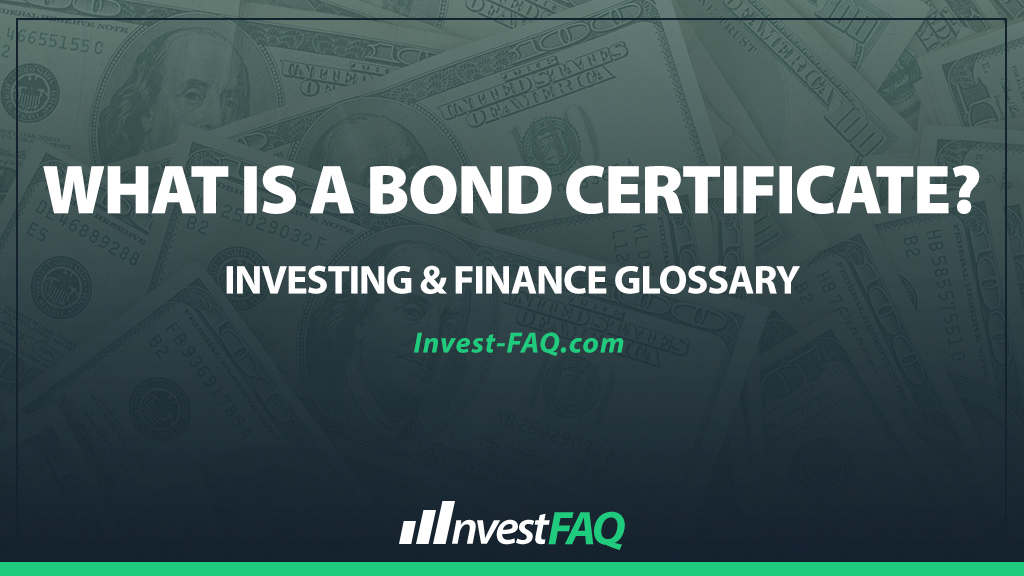
Bond Certificate
Contents
A bond certificate is a physical document that represents an investment in a bond, issued by the bond issuer to the bondholder. It includes critical details such as the bond’s par value, interest rate, maturity date, and issuer information, serving as evidence of the bondholder’s investment and the issuer’s obligation to pay back the borrowed funds with interest.
In the business and financial world, bond certificates are crucial for both issuers and investors. For issuers, such as corporations or governments, issuing bonds is a method of raising capital by borrowing money from investors under specific terms.
Investors, on the other hand, receive bond certificates as proof of their investment, entitling them to future interest payments and the return of the principal amount at maturity.
While the trend has moved towards electronic record-keeping, bond certificates remain a symbol of the transaction and can be important in certain legal or historical contexts.
Example of a Bond Certificate
Imagine “Infrastructure Development Corp.” (IDC) issues a series of bonds to finance a new construction project. Each bond has a par value of $1,000, an annual interest rate of 5%, and a maturity date 10 years from the issue date. An investor purchases a bond and receives a bond certificate detailing these terms.
In IDC’s accounting records, this transaction results in:
Cash (Asset): Increase by $1,000, reflecting the inflow from the bond sale.
Bonds Payable (Liability): Increase by $1,000, representing IDC’s obligation to repay the bondholder at maturity.
Each year, IDC also records interest expense:
Interest Expense (Income Statement): $50 (5% of $1,000)
Cash (Asset): Decrease by $50 when the interest payment is made.
In this scenario, the bond certificate serves as the tangible evidence of the transaction between IDC and the investor. It outlines the investor’s rights to receive annual interest payments of $50 and the principal amount of $1,000 at the bond’s maturity.
For IDC, the transaction increases its cash assets, providing the necessary funds for its project, but also creates a long-term liability that must be managed over the bond’s life.
The certificate itself, while an important legal document, does not impact the accounting entries directly but underpins the financial relationship and obligations represented in those entries.
Significance for Investing & Finance
The concept of a bond certificate is significant in accounting for several reasons:
Evidence of Transaction: It provides physical evidence of the bond issuance transaction, detailing the terms agreed upon by the issuer and the investor.
Legal Obligation: It signifies the issuer’s legal obligation to pay interest and repay the principal to the bondholder, which is critical for both financial reporting and legal purposes.
Record of Investment: For investors, it serves as a record of their investment, outlining their rights to future cash flows from the issuer.
Historical Value: While the move to digital records has made physical certificates less common, they still hold historical value and can be important in certain contexts, such as proving ownership in the absence of electronic records.
In summary, a bond certificate is a foundational document in bond issuance, symbolizing the financial and legal relationship between issuer and investor.
It plays a critical role in the accounting and documentation of bond transactions, serving as a key record of the terms, obligations, and rights associated with bond investments.
FAQ
What information is typically included on a bond certificate?
A bond certificate includes essential details such as the bond’s par value, interest rate, maturity date, and the issuer’s name, providing a comprehensive overview of the bond’s terms and the obligations between the issuer and the investor.
How has the transition to electronic record-keeping impacted the use of physical bond certificates?
The shift to electronic record-keeping has significantly reduced the issuance of physical bond certificates, streamlining transactions and record management, although physical certificates may still be issued upon request or for commemorative purposes.
Can a bond certificate be transferred to another investor?
Yes, a bond certificate can be transferred to another investor, but the transfer must be registered with the issuer or the issuer’s agent to officially recognize the new owner’s entitlement to the bond’s interest payments and principal repayment.
What role does a bond certificate play in the event of a dispute between the issuer and the bondholder?
In the event of a dispute, a bond certificate serves as a legal document that outlines the terms of the bond, providing a clear basis for resolving disagreements regarding interest payments, principal repayment, or other terms outlined in the certificate.
